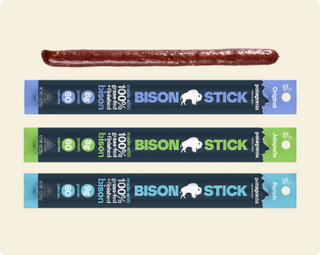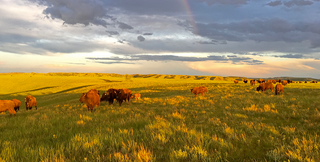Photo by Jon Levitt
Our bison sticks support efforts to restore the vanishing Great Plains grasslands, which provide one of Earth’s great carbon storage systems. The once thriving prairie that stretches from the Mississippi River to the Rockies has been decimated by years of land mismanagement and commercial farming. As growing evidence shows that restoring the health of our soil is key to slowing climate change, it’s critical to seek food sources that build soil health, rather than destroy it.
A unique environmental benefit of the Great Plains is their ability to store carbon underground. This is referred to as a “carbon sink,” which distinguishes grasslands from the way forests store carbon above ground, in woody biomass and leaves. Although trees have the ability to store vast amounts of carbon, when forests burn, that carbon is pumped back into the atmosphere. As wildfires become increasingly prevalent, revitalized grasslands offer the unique ability to adapt to the current realities of the climate crisis, storing carbon safely in the roots and soil.

Bison play an essential role in the Great Plains as a “keystone species,” supporting biodiversity and maintaining a complex habitat that provides resources for other species. Their grazing patterns and physical interaction with the land allow native plants to thrive, bringing the entire ecosystem into balance. As “gardeners of the prairie” bison do much more for their environment than meets the eye: when bison roam, the shallow imprint of their hooves aerate the compacted soil, digging openings for new seeds to sprout, and they also fertilize the soil with essential nutrients. Then, as the bison brush against ripe grasses, seeds attach to their shaggy coats. These seeds are dispersed as the bison move throughout the plains, enabling new growth, and creating habitats for an estimated 2,095 species that include native birds, reptiles, and mammals.
As the populations of bison that once numbered in the tens of millions across North America were wiped out, so was the health of the Great Plains topsoil, which were once among the richest on earth. Overgrazing cattle and other harmful agricultural practices have only made matters worse over time. While bison tend to move frequently when they graze, the cattle that took their place on the plains tend to concentrate in areas with water and shade. This throws the entire ecosystem out of balance, causing overgrazing in some areas and the abandonment of others. The wider grazing patterns of bison support the full diversity of habitats across the plains— as they feed across both short and tall grasses —helping all native plants and animals thrive.
Industrialized agriculture has further disrupted the natural state of the Great Plains by stripping the soil of its nutrients and leaving vast swaths of land contaminated by chemical fertilizers and pesticides. Moreover, confined animal feeding operations (CAFOs) for industrialized meat production have become a leading contributor to global warming, with more than 70% of all crops that are grown going to feed animals in confinement. These cattle are a major source of greenhouse gas emissions—accounting for at least 12-percent of all emissions globally—as a result of their grain-fed diet, which generates methane.
Where CAFOs and industrialized agriculture harm the environment and contribute to climate change, our bison sticks shows how meat production can have the opposite effect: drawing down carbon and restoring habitats.

Photo by Jon Levitt
Grasslands account for more than 20% of the world’s land area. Returning bison and other keystone species back to these habitats allows the soil to provide its essential functions: nutrient cycling, regulating drainage and the flow of water, and sustaining the plant life that captures greenhouse gases.
While the prairie grasses where bison roam appear small, beneath the ground are long, tangled roots. These roots are what give the plains their impressive ability to capture CO2 from the air. Wild Idea Buffalo and their affiliated ranches are already helping restore more than 500,000 acres of grasslands, which actively draw down and store more than 388,000 metric tons of carbon. That’s one of several reasons we have partnered with Wild Idea Buffalo to source the bison in our bison meat sticks.

In 2015, we partnered with Applied Ecological Services (AES) to study the link between prairie restoration and carbon capture. The initial findings showed that Wild Idea’s soil had higher carbon levels than conventionally managed cattle ranches nearby, confirming that native vegetation is more effective in removing CO2 from the atmosphere.
By restoring bison populations in their native homelands meat production becomes part of a thriving ecosystem and a key tool in mitigating the climate crisis. “Conservation and the protection of prairie biodiversity are our main products,” says Dan O’Brien, the founder of Wild Idea. “Bison meat is the delicious byproduct that (sometimes) helps pay the bills.”
While bison have long existed as a symbol of the freedom and openness of the Great Plains, they have also become an important symbol of environmental restoration. Their return to the plains presents a symbiotic alternative to the damaging and extractive methods of industrialized meat production. They help break patterns of consumption that cause environmental harm. leading us to food choices that restore a vital North American ecosystem while aiding in the battle against climate change.





